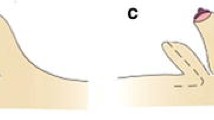Abstract
Background
Type I tuberous breast deformity (according to Grolleau’s classification) is characterized by the hypoplasia of the lower medial quadrant of the mammary gland and ptosis of the lower lateral quadrant. This results in an aesthetic imbalance in the breast that has an unnatural and unattractive appearance. The study aims to propose a surgical technique ensuring the successful correction of hypoplasia of the lower medial gland quadrant combined with ptosis. The essence of the technique is augmentation mastopexy with circumlateral vertical access. In the presence of pronounced ptosis of the breast, it is combined with the horizontal component and rotation of the gland flap.
Methods
The participants in the study were 26 patients (51 breasts) who were treated for type I tuberous breast deformity from 2015 to 2020. The average age of the patients was 34 years (within the range of 27–42 years). Patients from Group I were treated using the technique of circumlateral vertical mastopexy, and patients from Group II using circumlateral vertical augmentation mastopexy with a horizontal component.
Results
The average follow-up period was 36 months (9–60 months). Treatment was aimed to correct tuberous breast deformations of type I (according to Grolleau) combined with varying degrees of ptosis. The complication rate for all patients in this study was 5.4%—1 patient (1.8%) had a hematoma, 1 (1.8%) had postoperative implant malposition, and 1 (1.8%) had visibility and palpability of the implant edges.
Conclusions
Circumlateral vertical access can be applied for augmentation mastopexy in patients who wish to simultaneously correct ptosis and type I tuberous breast deformity and perform breast augmentation.
Level of Evidence IV
This journal requires that authors assign a level of evidence to each article. For a full description of these Evidence-Based Medicine ratings, please refer to the Table of Contents or the online Instructions to Authors www.springer.com/00266.





Similar content being viewed by others
References
Rees TD, Aston SJ (1976) The tuberous breast. Clin Plast Surg 3:339–347
Brown MH, Somogyi RB (2015) Surgical strategies in the correction of the tuberous breast. Clin Plast Surg 42:531–549
Groleau J-L, Lanfrey E, Lavigne B, Chavoin J-P, Costagliola M (1999) Breast base anomalies: treatment strategy for tuberous breast, minor deformities, and asymmetry. Plast Reconstr Surg 104:2040
Tebbetts JB (2001) Dual plane breast augmentation: optimizing implant-soft-tissue relationships in a wide range of breast types. Plast Reconstr Surg 107:1255–1272
Tebbetts JB (2006) Dual plane breast augmentation: optimizing implant-soft-tissue relationships in a wide range of breast types. Plast Reconstr Surg 118:81–98
Benelli L (1990) A new periareolar mammaplasty: the “round block” technique. Aesthetic Plast Surg 14:93–100
Pusic AL, Klassen AF, Scott AM, Klok JA, Cordeiro PG, Cano SJ (2009) Development of a new patient-reported outcome measure for breast surgery: the BREAST-Q. Plast Reconstr Surg 124:345–353
Mandrekas AD, Zambacos GJ, Anastasopoulos A, Hapsas D, Lambrinaki N, Ioannidou Mouzaka L (2003) Aesthetic reconstruction of the tuberous breast deformity. Plast Reconstr Surg 112:1099–1108
Zholtikov V, Korableva N, Lebedeva J (2019) Tuberous breast deformity correction: 12-year experience. Aesthetic Plast Surg 43(1):15–26
De Luca Pytell DM, Piazza RC, Holding JC, Snyder N, Hunsicker LM, Phillips LG (2005) The incidence of tuberous breast deformity in asymmetric and symmetric mammaplasty patients. Plast Reconstr Surg 116:1894–1899
Kolker AR, Collins MS (2015) Tuberous breast deformity: classification and treatment strategy for improving consistency in aesthetic correction. Plast Reconstr Surg 135(1):73–86. https://doi.org/10.1097/prs.0000000000000823
Gulyas G (2004) Marking the position of the nipple-areola complex for mastopexy and breast reduction surgery. Plast Reconstr Surg 113(7):2085–2090
Hammond DC (2014) The lower island flap transposition (LIFT) technique for control of the upper pole in circumvertical mastopexy. Plast Reconstr Surg 134:655–660
Von Heimburg D, Exner K, Kruft S, Lemperle G (1996) The tuberous breast deformity: classification and treatment. Br J Plast Surg 49:339–345
Bruck HG (1992) Hypoplasia of the lower medial quadrant of the breast. Aesthetic Plast Surg 16:283–286
Abbate OA, Fan KL, Nahabedian MY (2017) Central mound mastopexy for the correction tuberous/tubular breast deformity. Plast Reconstr Surg 5:1545
Panchapakesan V, Brown MH (2009) Management of tuberous breast deformity with anatomic cohesive silicone gel breast implants. Aesthetic Plast Surg 33:49–53
Brown MH, Shenker R, Silver SA (2005) Cohesive silicone gel breast implants in aesthetic and reconstructive breast surgery. Plast Reconstr Surg 116:768–779
Gasperoni C, Salgarello M, Gargani G (1987) Tubular breast deformity: a new surgical approach. Eur J Plast Surg 9:141–145
Persichetti P, Cagli B, Tenna S (2005) Decision making in the treatment of tuberous and tubular breasts: volume adjustment as a crucial stage in the surgical strategy. Aesthetic Plast Surg 29:482–488
Mandrekas AD, Zambacos GJ (2010) Aesthetic reconstruction of the tuberous breast deformity: a 10-year experience. Aesthet Surg J 30:680–692
Author information
Authors and Affiliations
Corresponding author
Ethics declarations
Conflict of interest
The authors declare that they have no conflicts of interest to disclose.
Human or Animal Rights
This article does not contain any studies with animals performed by any of the authors.
Informed Consent
For this type of study informed consent is not required.
Additional information
Publisher's Note
Springer Nature remains neutral with regard to jurisdictional claims in published maps and institutional affiliations.
Rights and permissions
About this article
Cite this article
Zholtikov, V., Korableva, N. & Lebedeva, Y. Circumlateral Vertical Augmentation Mastopexy for the Correction of Ptosis and Hypoplasia of the Lower Medial Quadrant in Tuberous Breast Deformity. Aesth Plast Surg 45, 40–47 (2021). https://doi.org/10.1007/s00266-020-01977-8
Received:
Accepted:
Published:
Issue Date:
DOI: https://doi.org/10.1007/s00266-020-01977-8




